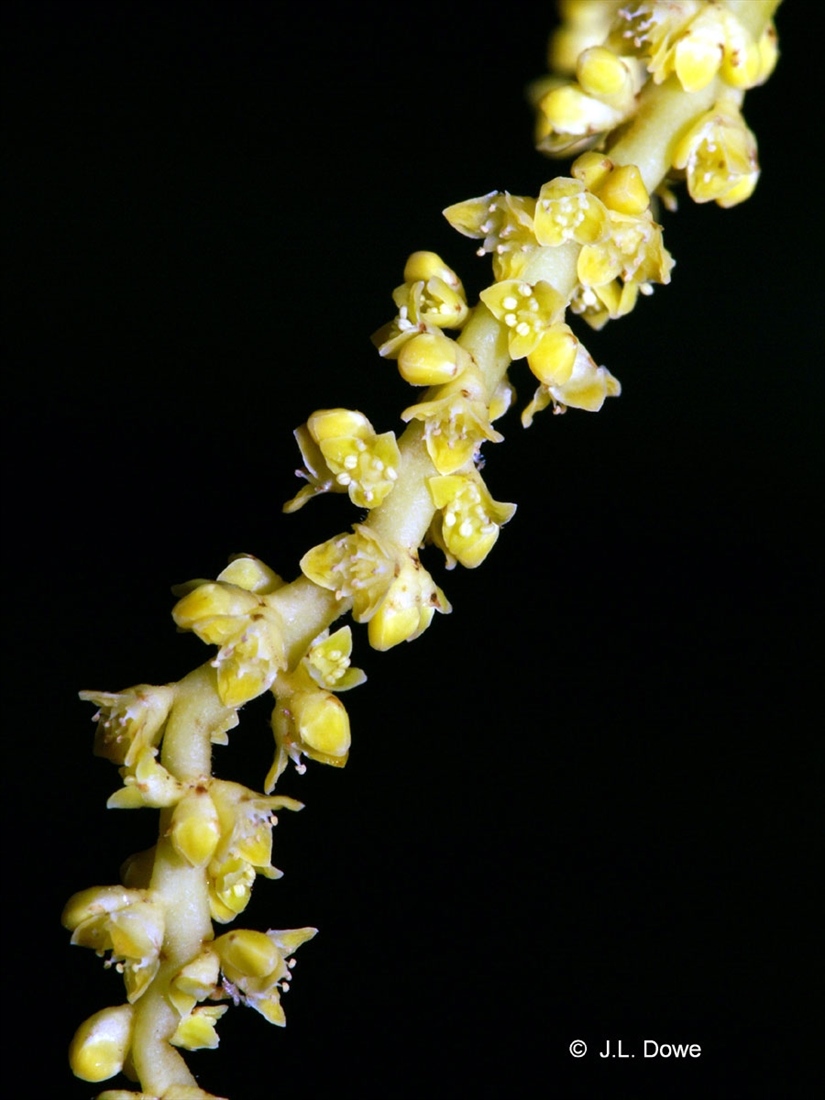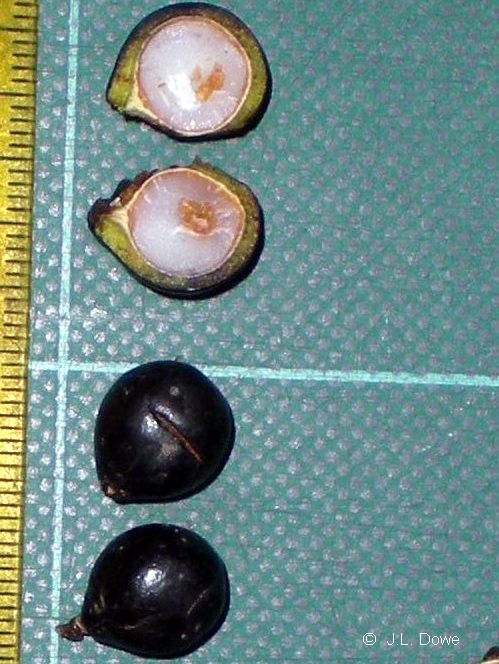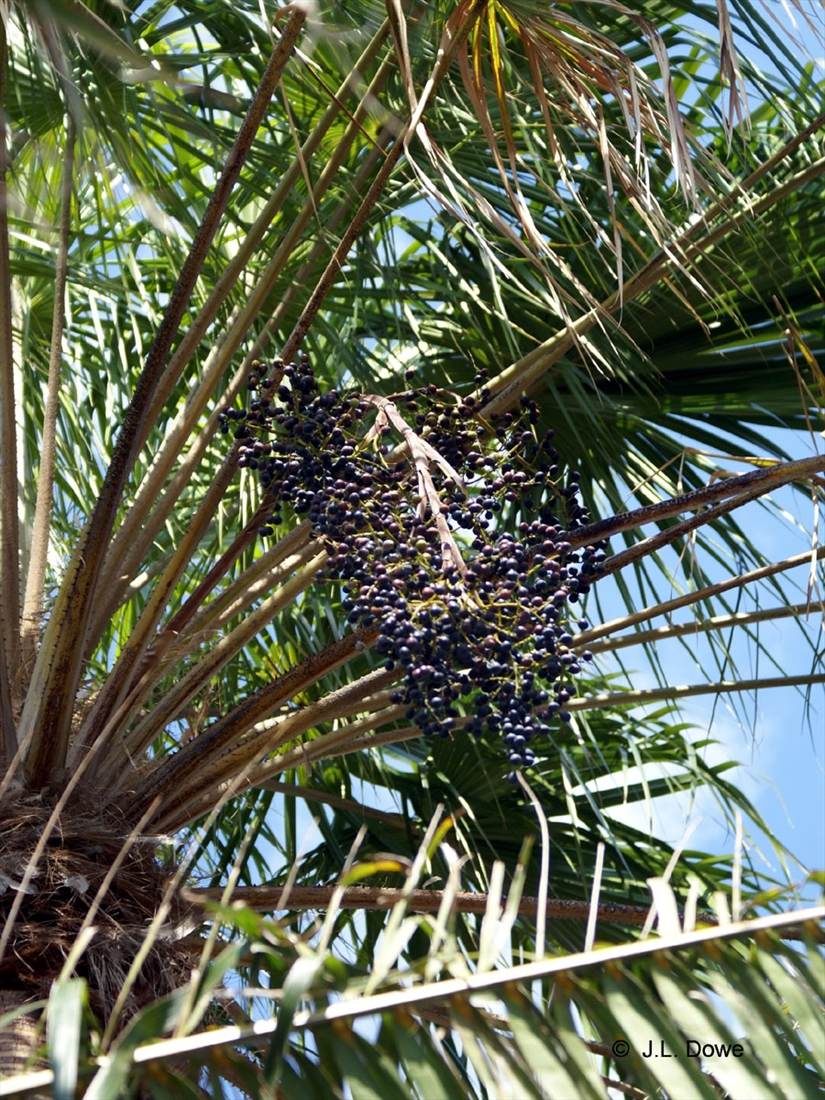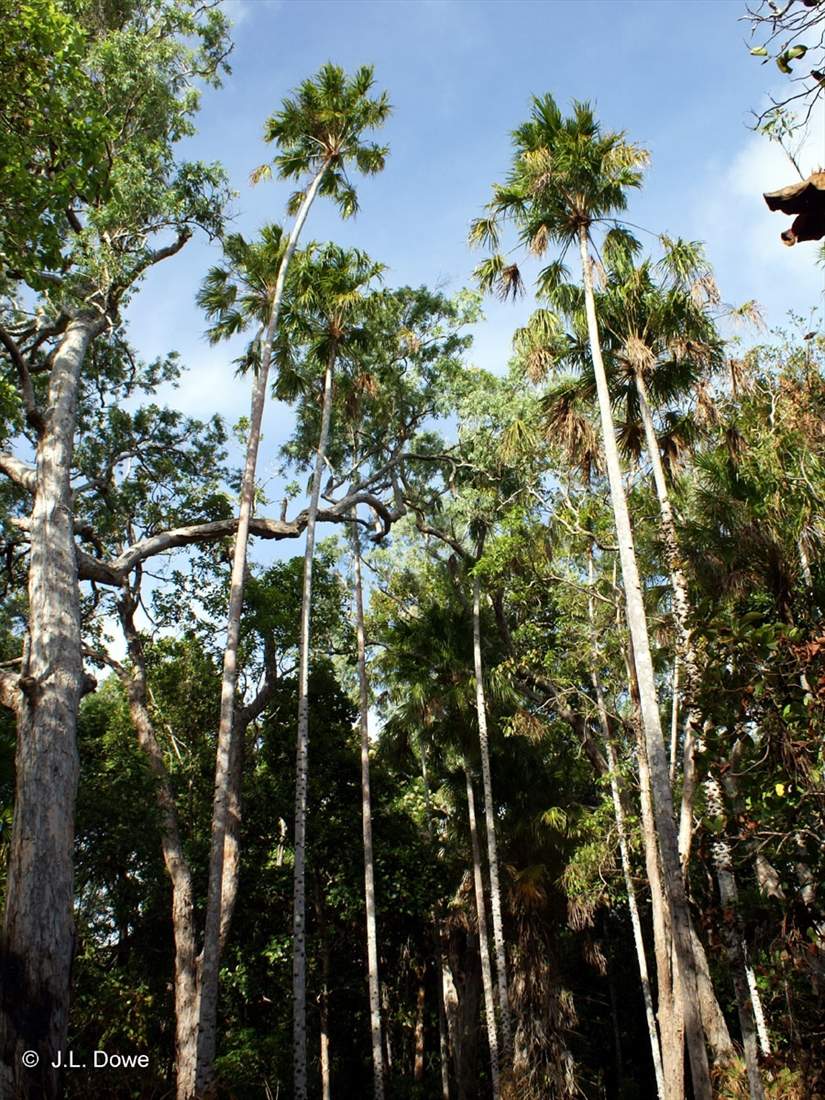Australian Tropical Rainforest Plants - Online edition
Livistona benthamii F.M.Bailey





Bailey, F.M. (1902) The Queensland Flora 5: 1683. Type: Somerset, Cape York Peninsula, Frank L. Jardine.
Fan Palm; Cabbage Palm
Trunk solitary, straight, to 17 (-20) m high, 12-14 cm diameter in upper part, broadening gradually from about 5 m above ground in a long cone to 30 cm or more diameter just above roots. Surface fairly smooth; vertical fissures numerous and regular but shallow; basal 5 m or so usually bearing persistent, patent or slightly deflexed 10-40 cm long petiole-stubs. Plants functionally male or female.
Crown densely globose in adult state but greatly elongated in pre-flowering plants, consisting of 30-50 ascending to spreading leaves with pendulous segment-lobes, the lower leaves slightly drooping. Petiole (120-)160-180 (-210) cm long, 10-18 mm wide, roughly semi-circular in t.s. with slightly flared margins and 2 concave grooves either side of a median ridge above. Margins virtually unarmed in upper half; toward base armed with ± closely spaced pungent, narrowly triangular-conical, patent to retrorse shiny brownish-black prickles to 6 mm long. Surfaces pale green, obscurely striate. Hastula flat with upturned edges to semicylindrical; base broadly 2-lobed with shallow median notch or 3-lobed with lateral lobes wider than central. Lamina moderately to strongly costapalmate with broad basal sinus, 70-115 cm long, chartaceous-coriaceous, moderately tough. Segments 29-39 either side of costa; largest segments 23-32 mm wide, broadening slightly toward point of bifurcation, free for 60-75% of their length, bifurcated for 50-65% of free length, the lobes slightly diverging, evenly tapering into soft, early-necrotic, acute apices. Major longitudinal veins 6-9 either side of abaxial rib, prominent above and below; transverse veins evident both sides but more prominent below, mostly at low angles to longitudinal veins. Surfaces olive-green, duller beneath, drying to pinkish-brown above contrasting strongly with greenish-brown beneath, glabrous except for few white chaffy scales on bases of ribs.
Inflorescences shorter than petioles. Partial inflorescences c. 9, subequal, short relative to rachis; rachillae (1-)5-12 cm long, 0.6-0.7 mm thick, reddish-brown (fruiting stage), finely and closely but shallowly striate, minutely but patchily strigose-pubescent with twisted, semi-appressed hairs. Rachis bracts flattened-cylindrical, the largest 20-22 mm diameter, smooth and tightly sheathing, very stiffly coriaceous and rather hard, pinkish-brown ageing to red-brown or greyish, finely but shallowly striate, patchily clothed with closely appressed silvery scales; bract apices triangular-ovate, smoothly acuminate. Flower-clusters 1-4 mm apart, 1-2(-3)-flowered; cluster axis 0.5-1.2 mm long, cylindrical or somewhat bulging. Cluster-bract caducous. Bracteoles not discernible. Flowers c. 1.5 mm long. Anthopodium 0.3-0.5(-0.8)mm long, wider than long, recessed at base and bluntly trigonous. Sepals very concave, membranous, thickening only close to base, 0.8-2.0 mm long, basally connate; free portion triangular, acute. Petals slightly concave, thick and leathery, c. 1.3 mm long, connate for ca. 15% of their length, broadly triangular-ovate, acute or subacute, slightly mucronate, auriculate at the base with relatively large, diverging auricles. Stamens slightly shorter than petals, connate for 25-30% of their length; filaments thick, broadly triangular-ovate, gently rounded either side toward base, tapering smoothly to a slender apex.
Fruit obovoid-pyriform narrowing into prominent slender nipple at the base, slightly flattened ventrally, 9-13 x 9-11 mm; usually with floral remains attached, the enlarged anthopodium and torus forming an extension c. 1 mm long. Epicarp blackish when ripe with thin glaucous bloom, quite smooth, thin and weak. Mesocarp c. 0.7 mm thick (dry), greenish and juicy when fresh, granular when dry. Endocarp 0.2 mm thick, horny but rather brittle, smooth and dark red-brown on inner face, outer surface with widely but irregularly spaced narrow longitudinal ridges. Seed subspherical or slightly ovoid, flattened ventrally, 8-9 x 7-8 mm; surface smooth and dark brown.
Features not available.
Occurs in the NT and CYP. Altitudinal range from near sea level to 100 m. Grows along streams and rivers and swampy places in gallery forest, vine forest and Melaleuca swamp forest. Also from New Guinea.
Readily available in most N.T. nurseries and is gradually gaining acceptance with local gardeners. It makes a very attractive patio specimen when grown in a large tub.
The central growing tip is eaten raw or lightly roasted.





